See also
Upper limb non-use
Key Points
- Diagnosis of pulled elbow is made clinically with a supporting history and examination
- It is a common injury in toddlers (1-4 years)
- Reduction manoeuvres are used to treat a pulled elbow
Assessment
History
- Age: usually 1 to 4 years old
- In 50% there is no history of a "pull" on the arm
Examination
- Not using the affected limb
- Elbow in extension and the forearm in pronation (see picture below)
- Distressed only on elbow movement, especially pronation or supination
- No swelling, deformity or bruising of the elbow or wrist
- On palpation tenderness is usually absent (remember the clavicle)
- Marked resistance and pain with supination of the forearm
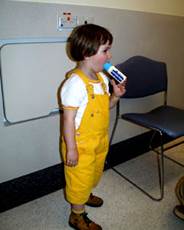
Management
Investigations
Plain radiographs are indicated when a differential diagnosis (see upper limb non-use) is suspected, including:
- if significant tenderness, swelling, bruising or deformity are present
- if reduction fails
Treatment
- Provide analgesia
- Especially if assessment or management is delayed or the diagnosis unclear
- Proceed with reduction promptly as this usually provides pain relief
- Perform a reduction manoeuvre (see below) if clinical diagnosis made
- Expect distress and pain with the manoeuvre
- A click may be felt over the radial head
- Review after ten minutes, most children will be using the arm again
- If reduction fails after the initial attempt
- Consult with senior medical staff and consider repeat reduction again after 15 minutes
- If unreduced after two attempts, consider X-ray
Reduction manoeuvres
Either of the following methods may be effective
Hyperpronation manoeuvre
Sit the child on the parent's lap
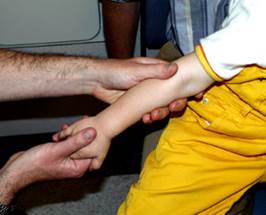 |
Support the elbow with one hand with gentle pressure from your thumb over the radial head (to palpate a ‘click’ on successful reduction) |
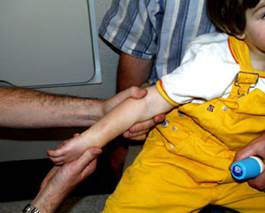
|
Fully pronate forearm |
Supination/flexion manoeuvre
Sit the child on the parent's lap
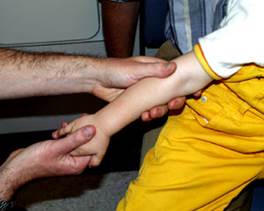 |
Support the elbow with one hand with gentle pressure from your thumb over the radial head (to palpate a ‘click’ on successful reduction) |
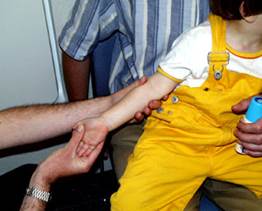
|
Supinate the forearm |
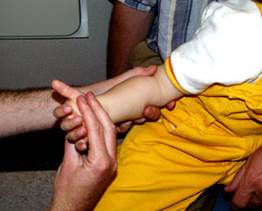
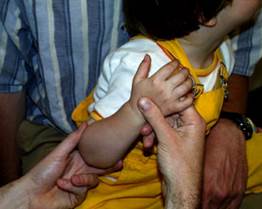
|
Flex the elbow |
If the reduction is successful, the child should be pain free and able to move the arm normally in 5 to 30 minutes, including being able to reach for an object above the head
In cases where reduction is felt to be successful, but the injury is greater than 12 hours old, the child may take 1-2 days to use the arm again
Consider consultation with local paediatric team when
A pulled elbow is unable to be reduced in the acute care setting
Consider transfer when
Child requiring care beyond the comfort level of the hospital
For emergency advice and paediatric or neonatal ICU transfers, see Retrieval Services
Consider discharge when
A pulled elbow is successfully reduced
In cases where reduction is felt to be successful, but the injury is greater than 12 hours old, the child may take 1-2 days to use the arm again
- The child can be discharged, with a broad arm sling and Emergency Department review in 48 hours
Parent information sheet
Pulled elbow
Last updated May 2023